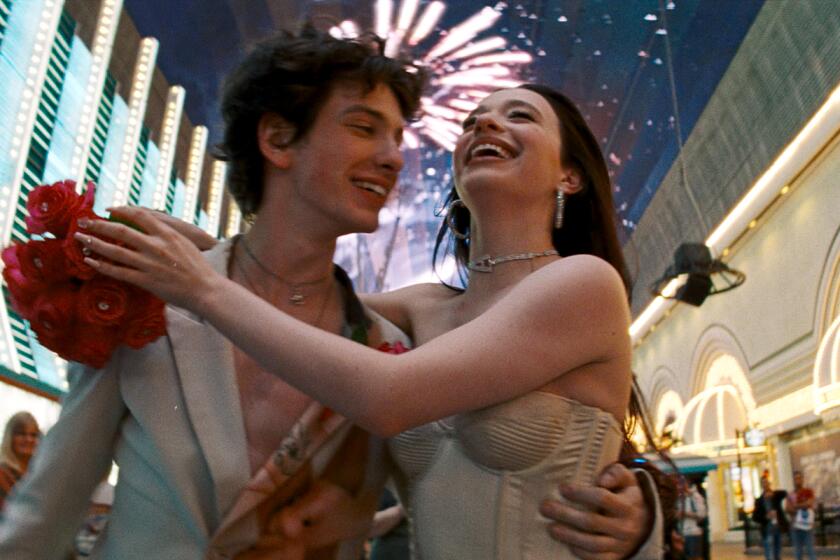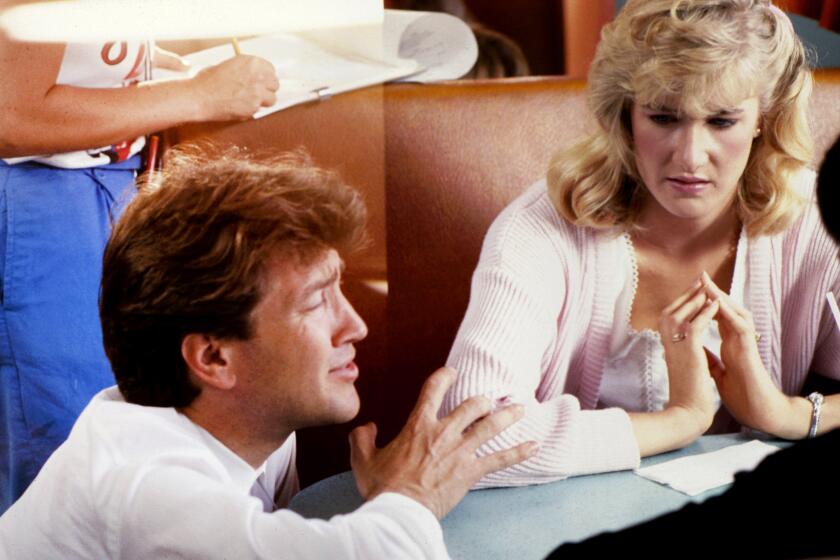SPOT THE OBSESSION
- Share via
Joyful, choreographed dance numbers staged in crumbling Mumbai train stations are not how most American films end. Yet when just such a scene crops up in “Slumdog Millionaire,” the moment is perfectly apt.
Sure, it’s a Bollywood-meets-Hollywood ending, and the train station is key to the film. But those familiar with Oscar-nominated scriptwriter Simon Beaufoy’s oeuvre may note that dancing-amid-decrepitude is almost a given. This is the man who had steelworkers shimmy in 1997’s “The Full Monty” and featured a line dance atop a gasometer in 1998’s “Among Giants.”
“I’m very big on industry and postindustrial landscapes,” admits Beaufoy. “I fell in love with Mumbai because it was industrial. And dance is really important to me -- it’s another kind of wordless expression.”
A close look at some of this year’s other screenwriter and director Oscar nominees reveals that Beaufoy is far from alone. Easy connections abound in individual bodies of work, as when Eric Roth’s boy-men (“The Curious Case of Benjamin Button” and “Forrest Gump”) travel through eras; or when director Danny Boyle’s bag-of-money fetish surfaces in “Shallow Grave” (1995), “Trainspotting” (1996), “A Life Less Ordinary” (1997), “Millions” (2004) and, yes, “Slumdog.”
But scriptwriters and directors worthy of award consideration are not just fitting familiar pieces together in the hopes of creating a great script. The age-old question of “Where do you get your ideas?” has a subsection for filmmakers -- “Where do you get your great scenes?”
The answer? No idea. Few filmmakers seem consciously aware of the choices they make when selecting subject matter or imagery that makes a script sing. It just -- comes. And when subject matter and creative inspiration are well-matched, great films emerge. Which means writers tend to go back to that same muse for inspiration the next time, and the next -- whether they realize it or not.
Take Peter Morgan. The Oscar nominee has spun gold out of the lives of Tony Blair, Queen Elizabeth II, Idi Amin, and now David Frost and Richard Nixon in “Frost/Nixon.” Morgan recognizes that he explores “the humanity of the powerful, and how incompatible humanity is with the successful execution of the ultimate office.”
He adds that he connects with elements of everyone he profiles. “Nixon’s humanity undid him,” he says. “Watergate is a wonderful articulation of a character defect.”
But he also recognizes the power of the metaphoric image. The appearance of the 14-point imperial stag (and its later evisceration) in “The Queen” provoked much discussion when the film was released, and Morgan says he’s “enjoyed other peoples’ interpretations” of that one scene.
“It was a moment of vulnerability [for the queen],” he explains. “She was really confronting herself and approaching mortality.”
There’s no large ungulate in “Frost/Nixon,” but Morgan admits he’s getting similar feedback from that film’s late-night phone call scene. “It seems to land with people in a way,” he says. “It’s also the piece of writing in the film that I’m most proud of, and it came most instinctively. It literally flew out of me in a second and for that reason I’m probably most attached to it.”
That unconscious letting go to fuel great scenes and stories is a singular achievement for a writer and can lend an otherwise straightforward story depth and resonance.
But few writers like to explore where it all comes from, as if explanation will destroy the magic.
Notes Beaufoy, “It’s very difficult to look back through one’s work to deconstruct it. It’s a slightly scary thing to do for a writer, in case you’re staring too closely at the magic of it. Things are in my armory of unconscious and they crop up. But I never sit down with a list of things I want to put in a film.”
Yet, not every powerful image in a film has to come from the subconscious realm. Screenwriter David Hare reteamed with director Stephen Daldry for “The Reader” (they shared duties on 2002’s “The Hours” and each earned an Oscar nomination), based on Bernhard Schlink’s novel -- once again diving into his pet subject, post-WWII society (as seen in 1985’s “Plenty” and 1974’s telefilm “Licking Hitler,” to name just two sources).
For “The Reader,” Hare realized he needed a climactic moment, and found it in a half-page scene from the book. He expanded it into the film’s climax and imbued a small tin of money with enormous importance.
“In the film you have this unbelievably powerful ready-made visual metaphor of the tin,” he explains. “It’s barely suggested in the book, but it’s been built up hugely in the film because I felt it needed to be the end of [the protagonist’s] search for some kind of peace.”
Hare and Daldry remain relatively unsentimental about their inspirational sources.
Notes Hare, “Subject matter is the only criteria by which I would start to write a film,” while Daldry says that, “In terms of visual exploration, personally, everything is servicing the piece that you’re doing.”
That said, Daldry is not unaware of returning to familiar subject matter. Though virtually every one of his films has been a period piece, he looks at it differently: “The thread throughout my stage work and film work is grief -- the grief of loss, the loss of a community losing its sense of self.”
Wherever inspiration comes from, Hare insists that great films are not all about the Important Metaphor or the Key Prop or even the Recurring Theme.
“We’re beaten over the head all the time: ‘Film is a visual medium,’ ” he says, noting that “everyone” expected concentration camp and burning church flashbacks in his script. “People kept saying, ‘It will be filmic to go back to those places.’ And I kept saying it wouldn’t be remotely filmic, it’d actually be quite insulting.”
Adds Hare, “There’s this false idea of what filmmaking is, meaning you plaster images all over the place -- such as flashbacks to illustrate speeches, which I think is a horrible convention. What is genuinely filmic? A human face.”
--
More to Read
Only good movies
Get the Indie Focus newsletter, Mark Olsen's weekly guide to the world of cinema.
You may occasionally receive promotional content from the Los Angeles Times.










